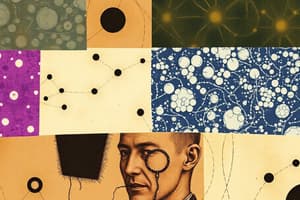Podcast
Questions and Answers
What is the primary function of the cell membrane?
What is the primary function of the cell membrane?
- To control the movement of substances into and out of the cell (correct)
- To store genetic information
- To provide structural support for the cell
- To produce energy for the cell
Which of the following is NOT a difference between plant and animal cells?
Which of the following is NOT a difference between plant and animal cells?
- Both plant and animal cells have a nucleus (correct)
- Plant cells have chloroplasts, while animal cells do not
- Plant cells have a cell wall, while animal cells do not
- Animal cells have lysosomes, while plant cells do not
What is the process by which water moves across a semipermeable membrane from a region of high water concentration to a region of low water concentration?
What is the process by which water moves across a semipermeable membrane from a region of high water concentration to a region of low water concentration?
- Osmosis (correct)
- Endocytosis
- Active transport
- Diffusion
Which of the following is an example of a unicellular organism?
Which of the following is an example of a unicellular organism?
Which type of tissue is responsible for contracting and relaxing to produce movement?
Which type of tissue is responsible for contracting and relaxing to produce movement?
Flashcards
Cell Theory: 3 Postulates
Cell Theory: 3 Postulates
All living things are made up of one or more cells. The cell is the basic unit of structure and function in living organisms. All cells come from pre-existing cells.
Main Parts of a Cell
Main Parts of a Cell
The plasma membrane is a selectively permeable barrier that controls what enters and exits the cell. It is composed of a phospholipid bilayer with embedded proteins. The cytoplasm is the gel-like substance that fills the cell and contains the organelles. The nucleus stores the cell's genetic material (DNA).
Diffusion and Osmosis
Diffusion and Osmosis
Diffusion is the movement of molecules from an area of high concentration to an area of low concentration. It is a passive process that doesn't require energy. Osmosis is the diffusion of water across a semi-permeable membrane from an area of high water concentration to an area of low water concentration.
Unicellular vs Multicellular
Unicellular vs Multicellular
Signup and view all the flashcards
Levels of Organization
Levels of Organization
Signup and view all the flashcards
Study Notes
Cell Theory
- All living things are composed of cells.
- Cells are the basic units of structure and function in living things.
- All cells arise from pre-existing cells.
Cell Structures and Organelles
- Cells contain various structures (organelles) that perform specific functions.
- Plant and animal cells have different structures to fulfill their specific functions.
Plant and Animal Cell Differences
- Plant cells have cell walls and chloroplasts, which animal cells lack.
- These differences impact their functions and overall structure.
Cellular Membranes
- Cell membranes are selectively permeable.
- They regulate what enters and exits the cell.
Cytosis
- There are three types of cytosis: endocytosis, exocytosis, and transcytosis.
Diffusion
- Diffusion is the movement of molecules from a high concentration to a low concentration.
- It's crucial for transporting substances within cells.
- Examples include oxygen moving into cells from the blood.
Osmosis
- Osmosis is the movement of water across a selectively permeable membrane from a high concentration of water to a low concentration of water.
- Osmosis is important for maintaining cell shape and volume.
- Examples include water moving into a cell placed in a hypotonic solution.
Unicellular vs. Multicellular Organisms
- Unicellular organisms consist of a single cell (e.g., bacteria, amoeba).
- Multicellular organisms are composed of multiple cells (e.g., plants, animals).
- Different levels of organization (cells, tissues, organs, organ systems) allow multicellular organisms complexity and efficient division of labor.
Cellular Organization
- Cells → Tissues → Organs → Organ Systems → Organisms
Human Tissue Types (Example: Epithelial Tissue)
- Epithelial tissue covers body surfaces and lines body cavities.
- Function: Protection, secretion, absorption.
Organ Systems (Example: Cardiovascular System)
- Cardiovascular System: Transports blood, oxygen, and nutrients throughout the body.
- Major organs: Heart, blood vessels (arteries, veins, capillaries).
Solution Tonicity
- Hypotonic: Solution with a lower concentration of solutes than the cell, causing water to enter the cell.
- Isotonic: Solution with an equal concentration of solutes as the cell, resulting in no net water movement.
- Hypertonic: Solution with a higher concentration of solutes than the cell, causing water to leave the cell.
Osmosis/Diffusion Examples
- Saltwater vs. Freshwater Fish: Saltwater fish are adapted to maintain their water balance in saltwater; freshwater fish would swell and die due to osmosis if they were placed in saltwater.
- Skittles Diffusion: The different colors of Skittles disperse in water due to diffusion.
- Egg Osmosis: Placing an egg in a solution affects the egg's shape and volume based on osmosis.
Studying That Suits You
Use AI to generate personalized quizzes and flashcards to suit your learning preferences.





